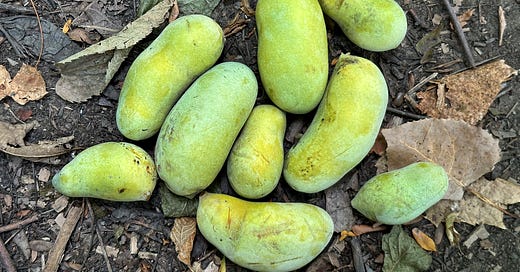I made a trip back to Ohio a week ago to visit family and it happened to align with paw paw (Asimina triloba) season, which is still going on, for another week, maybe two in the eastern United States. A couple of years ago I found a nice spot for wild paw paws in a neighboring town, but this year I went looking along the shores of the same creek I used to explore as a kid. I vaguely remember seeing the fruit there once, though no one knew what they were. No one I knew ate or sought out wild fruits, and I never even heard the name paw paw or saw one being eaten. There is just that faint memory of seeing them rotting on the ground and a sweet, tropical scent floating through the woods. Within about 10 minutes of looking, I found a patch of maybe 100 trees of varying sizes, maybe more.
Just to be clear, I’m not referring to the fruit referred to as paw paw in Australia, which the rest of the world calls papaya. If you don’t know what a paw paw is, it grows naturally throughout the Appalachian Mountain range and adjacent areas and looks a bit like a mango, an oblong green fruit that grows in clusters of two to nine. They only ripen on the tree and once picked or fallen, and they only last a few days before turning to mush, so there is little commercial market for the fresh fruits other than small amounts that you might find at farmers markets or on Facebook marketplace. Different cultivars have been developed and the flavors can vary quite a bit. From the fruits I picked in Ohio, some had a pale white pulp that was creamy and custardy, with a flavor close to a cherimoya, while others had a bright orange pulp that was more acidic, closer to a mango.
I gathered 50 or so fruits, most of which were already on the ground and in good shape or I shook off the trees. There were plenty more that would ripen in the weeks to come. They are perfect on their own and there is no better way to eat them than fresh, however, there are only so many you can eat in a day. I made paw paw butter with the fruits that needed to be consumed right away, while the ones I could get back home in New York, where I already have chiles fermenting in a jar in my kitchen, I made hot sauce with. Here is the recipe:
Keep reading with a 7-day free trial
Subscribe to New Worlder to keep reading this post and get 7 days of free access to the full post archives.




